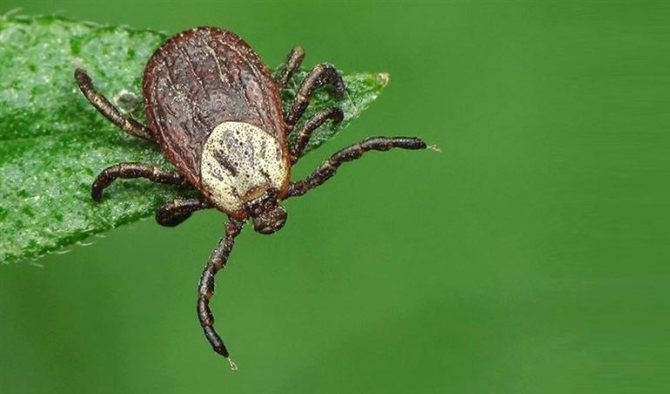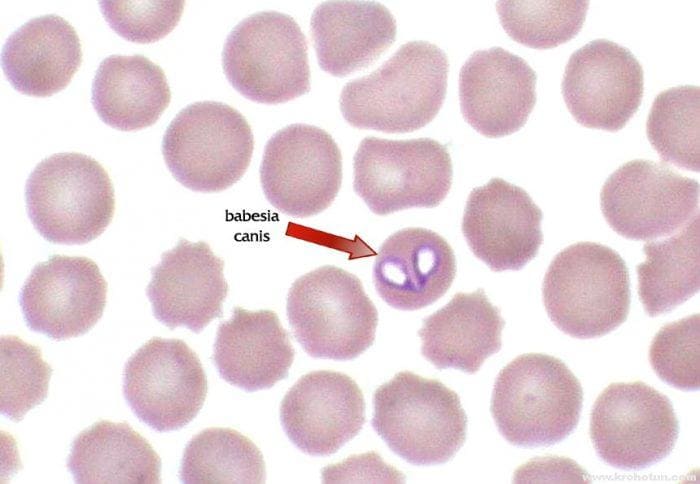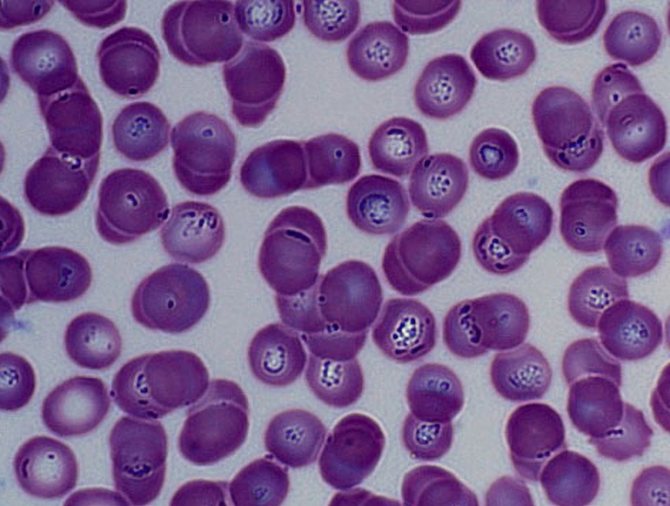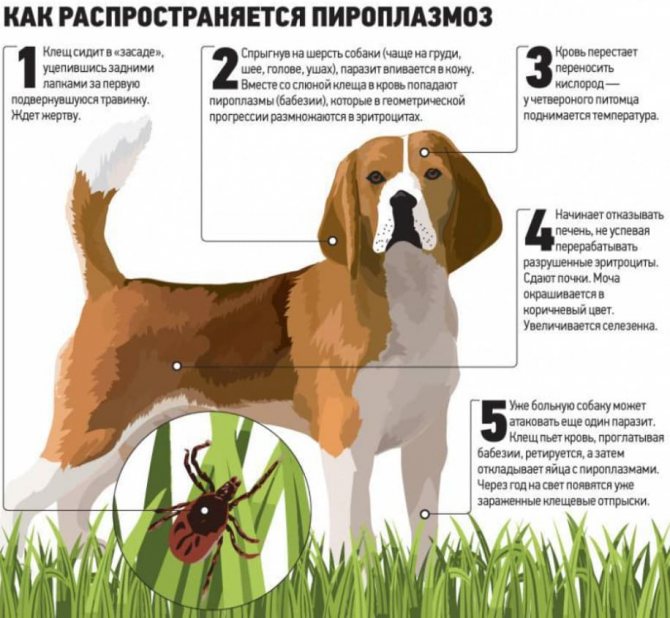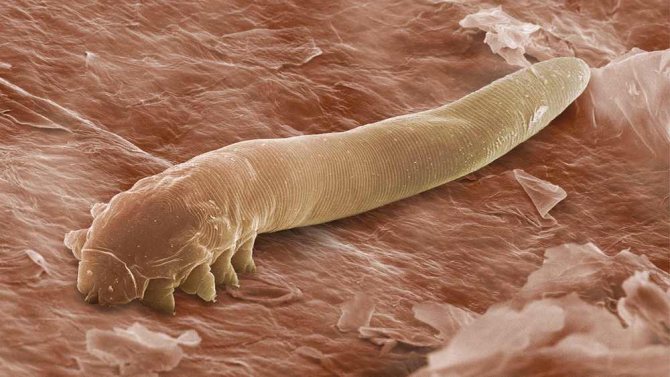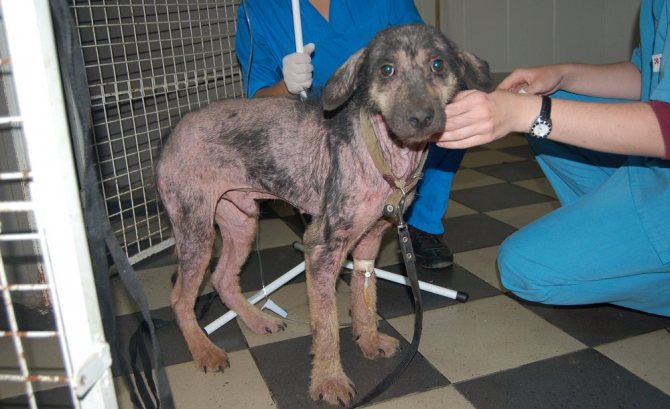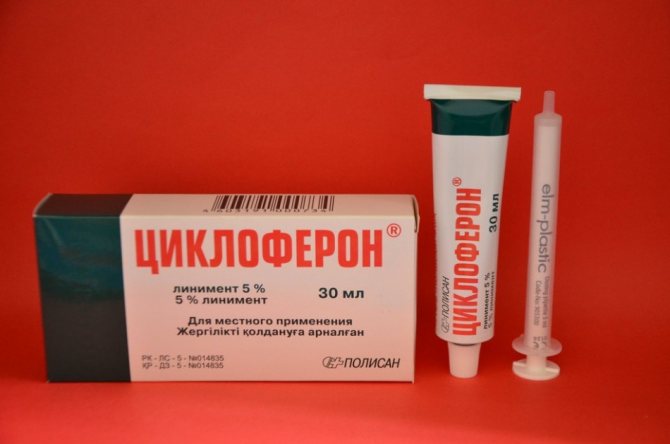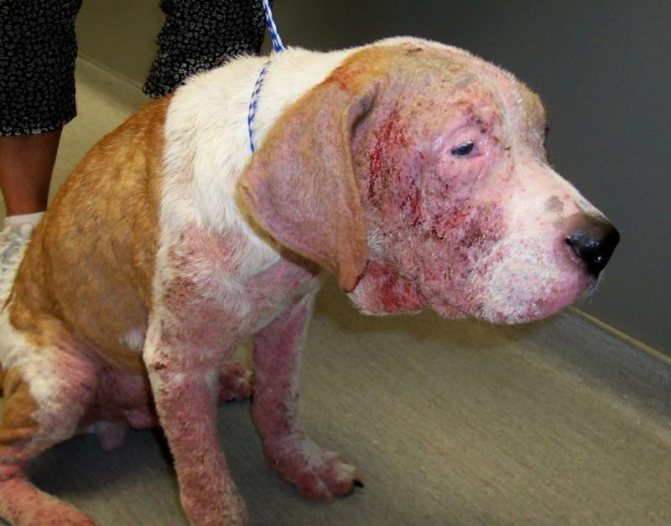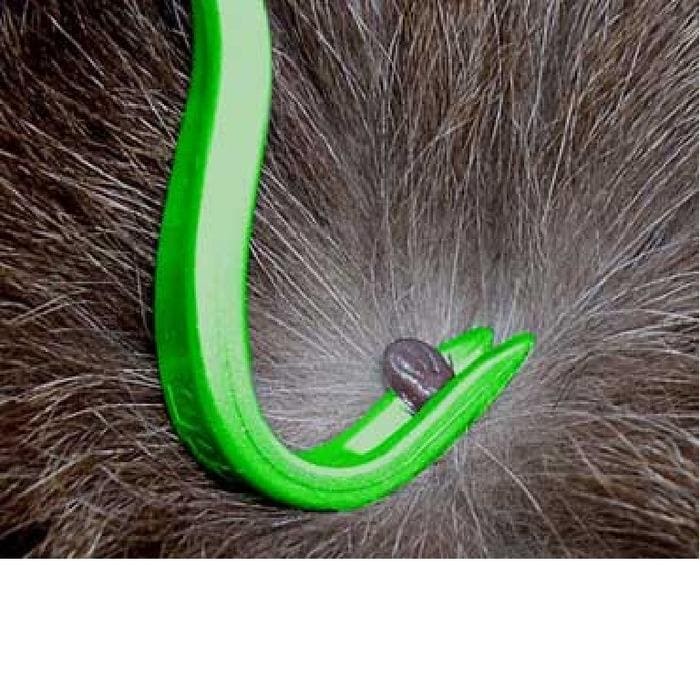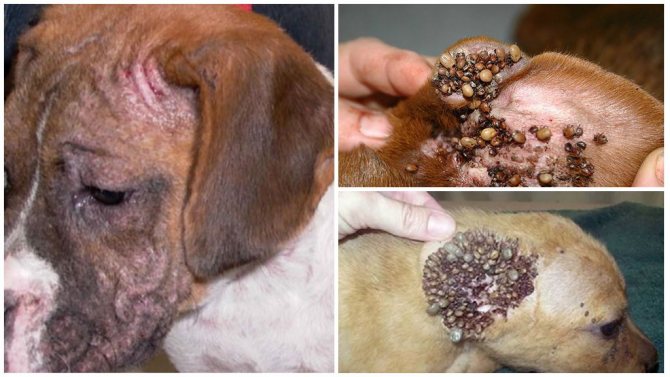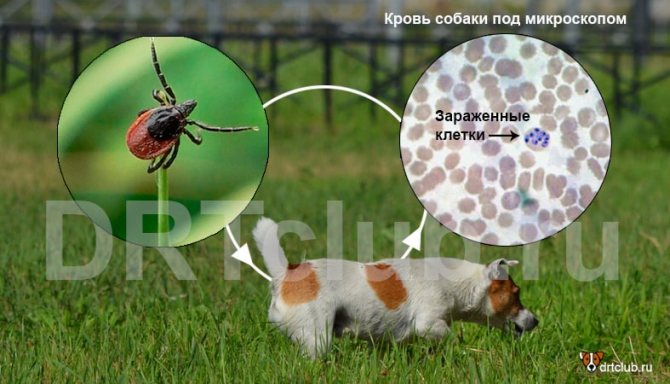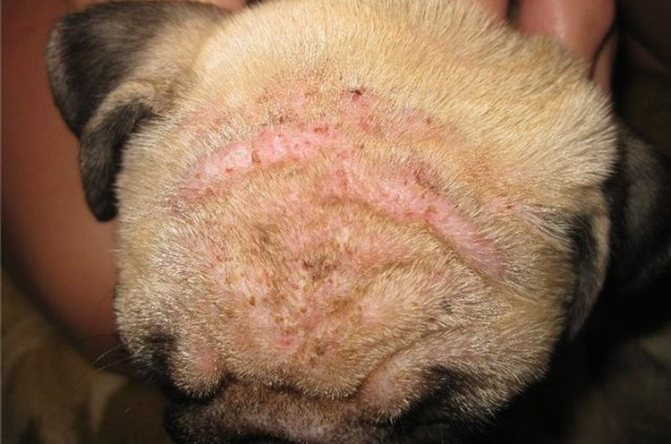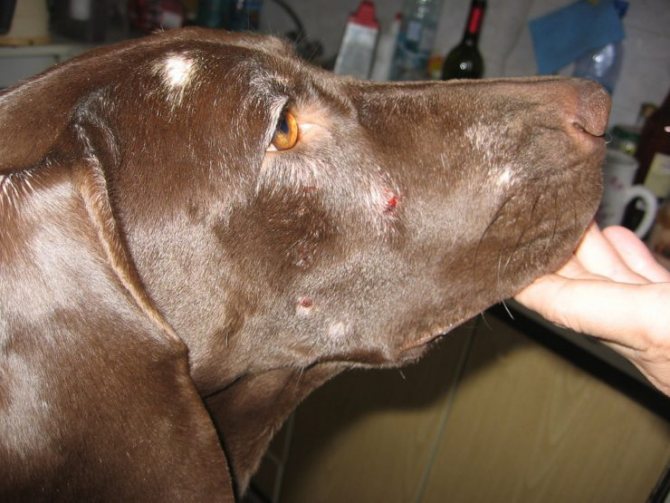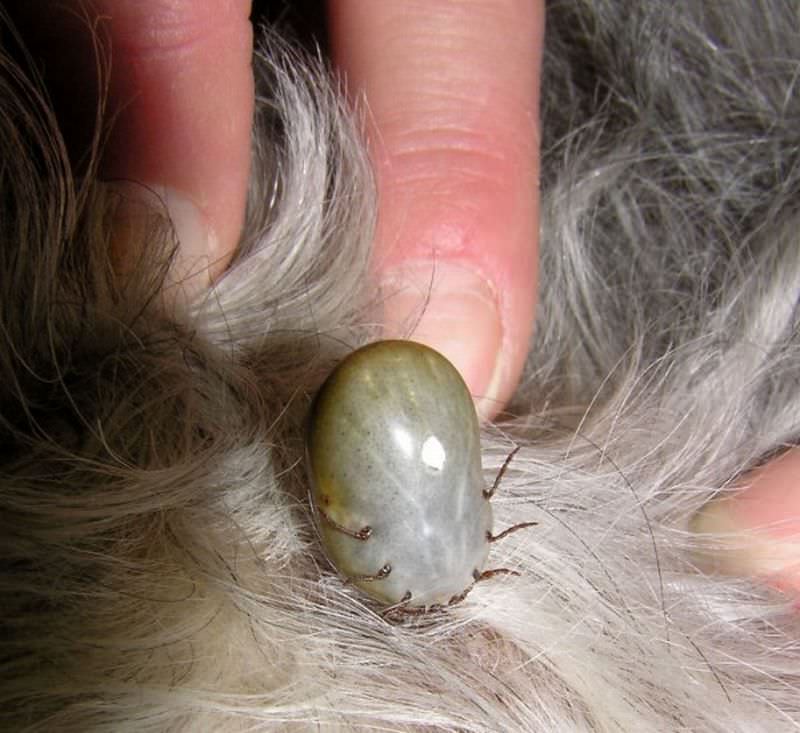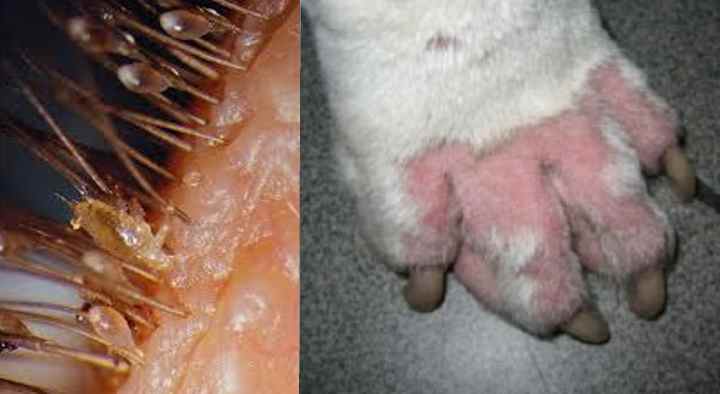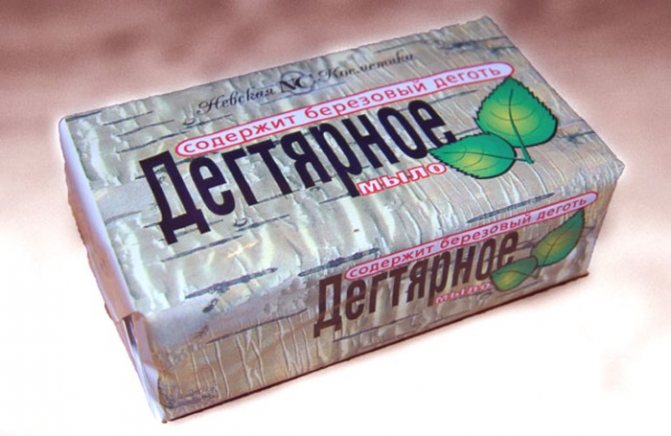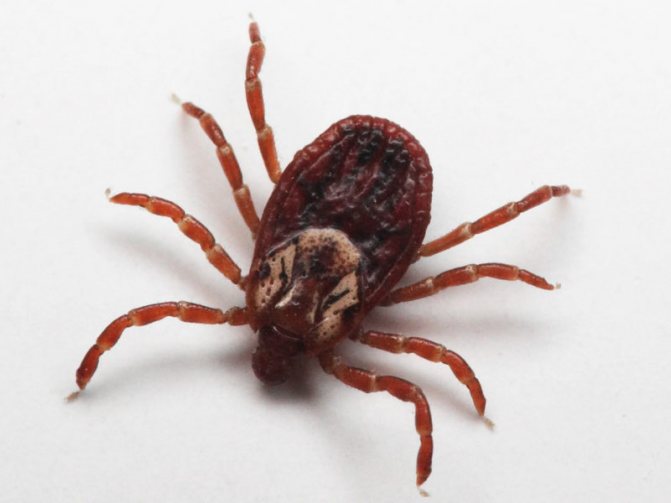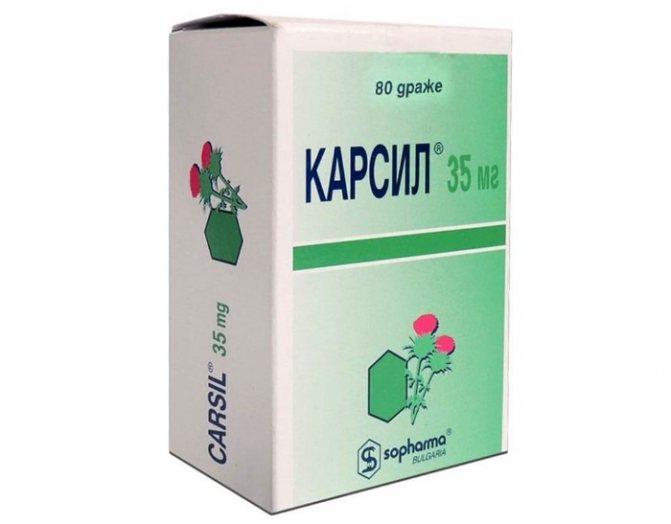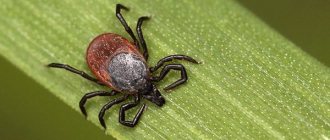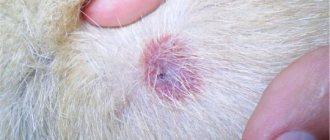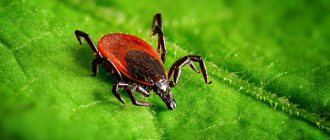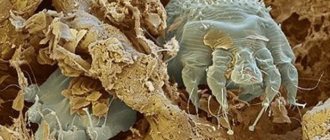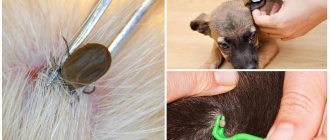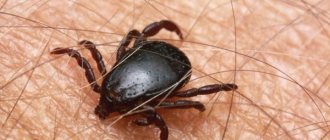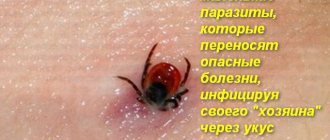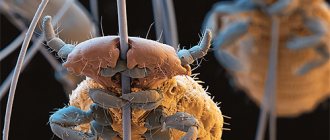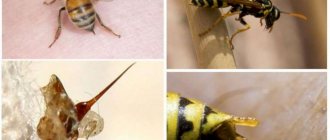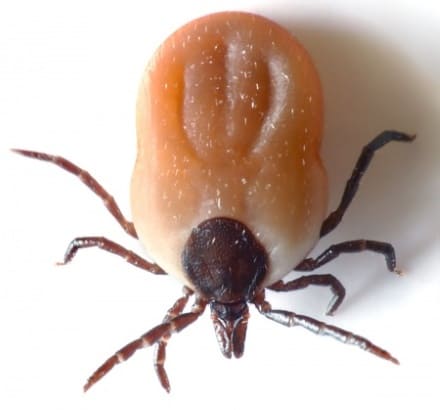
Mites Is the main cause of panic among dog owners. Due to the large number of infections carried by parasites, it is important for the health of a four-legged friend to understand the symptoms of manifestation and the main signs that arise after the animal has been bitten by ticks.
Consider what to do if a dog has been bitten by a tick, we will analyze the symptoms of tolerable diseases and the features of drug treatment, and also talk separately about the main signs of piroplasmosis found in dogs and its treatment.
What are the symptoms of piroplasmosis in a dog?
Owners of barking pets who first encounter a tick-borne attack do not really understand what symptoms to expect from a tick bite in a dog and what to do in the future. Indeed, many signs of piroplasmosis are similar to other canine sores - plague, enteritis, leptospirosis, which are not associated with a tick bite and require a completely different treatment.
A special problem is caused by the frequent fact when the dog was bitten by a tick, but it was not found on the body, and the owner may not realize for a long time that the deterioration of the condition of his four-footed friend is associated with a tick.
In each dog, the infection manifests itself in a purely individual way. The presence of pyroplasmas in the blood is more difficult to tolerate:
- puppies;
- young dogs;
- chronically sick dogs;
- purebred dogs.
Therefore, an understanding of the picture of the disease and what symptoms clearly indicate it will help to start emergency treatment on time.
- The earliest signs to help alert the owner is a decrease in dog activity. The dog loses its usually inherent playfulness, does not show joy, becomes apathetic, does not ask for a walk, stops jumping and running carelessly.
- The next initial symptoms that allow one to suspect piroplasmosis are loss of appetite and refusal not only from food, but also from a previously beloved and desired delicacy. Nutrition becomes problematic - the dog literally fails to feed. The fact that the dog turns away from the treat is the SOS signal in the first days of infection!
- After, on the 3rd - 5th day, more alarming signs of digestion appear - vomiting, often mucus, because the dog remained hungry all this time, and sometimes diarrhea with a characteristic bright yellow or greenish color of liquid masses. Symptoms of diarrhea are not always observed, and the stool may look normal, but the color changes to the indicated color.
- At the same time, you can already notice that the dog is trying to move less, as if it brings him suffering. Her steps are constrained, she prefers to constantly lie away from the master's eyes and not leave a secluded place. Such symptoms already indicate the progression of the disease.
- But the main signs of piroplasmosis are associated with a change in the color of urine - it darkens noticeably, acquiring a resemblance to beer or coffee, and may change to a dark brown color. Such symptoms unmistakably indicate precisely the pyroplasmas in the blood, destroying red blood cells, and the need to urgently begin treatment, otherwise irreversible processes can soon kill the dog.
- In healthy adult dogs, the picture may be completely asymptomatic, when the dog dies suddenly for the owners, without showing any special signs of discomfort before this.But an attentive owner, even with the usual behavior of his dog, will notice a changed suspicious color of urine, and guess that this is due to the consequences of a tick bite on his dog.
Important! As soon as the urine changed color, the expense of the pet's life, if you do not urgently start treatment, went for hours! On the fifth day after the onset of the disease, the dog dies! Already at this stage, you will have to take resuscitation measures.
Full recovery process
If an animal has suffered a disease such as piroplasmosis, then it must be properly rehabilitated, especially for elderly individuals that the tick could infect.
Thus, the animal must necessarily receive all the necessary vitamins and minerals, and it is also very important to pay attention that the greatest preference is given to those preparations that contain the maximum dose of iron in order to prevent the development of anemia in the pet as much as possible.
This is due to the fact that such a pathology is most of all due to the fact that in the process of the disease the level of red cells in the blood of the animal decreases as much as possible, which leads to severe anemia, which affects the state of the body as a whole.
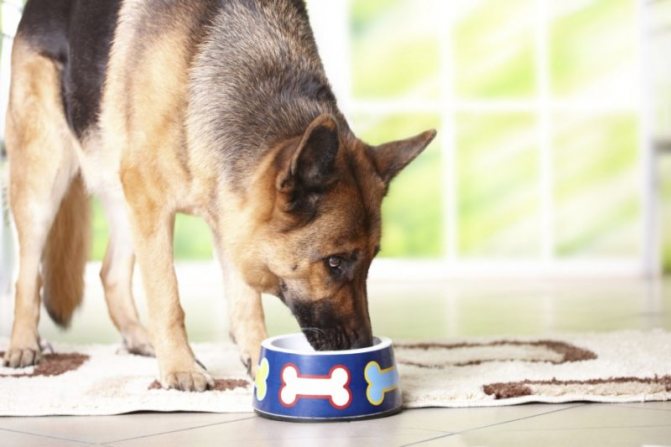

A dietary meal that is strongly recommended by your doctor also helps to raise this level, in most cases it is based on raw beef. It is worth excluding as much as possible those food products that can cause a process such as fermentation in the animal's body. Among these products you can find bakery products. It is also very important to consider that in the event that the pet eats only food, then you must give your preference to exactly the variety that is provided for dogs with a very sensitive digestive system.
If the disease is moderate, then it is imperative to limit the pet's physical activity, at least for a certain period of time. But, if the pet does not feel bad and there is a certain tendency towards recovery, then such loads can be renewed a little.
How a dog gets piroplasmosis
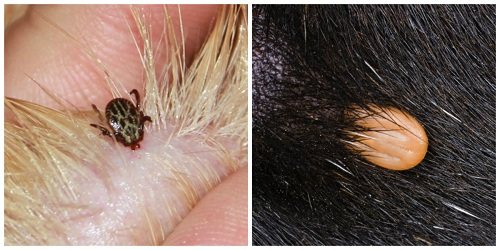

Tick on the dog's body
Pyroplasmas have two types of hosts during their cyclical development. The first as intermediate are dogs, foxes, wolves, jackals and other canines, and the second as the final ones are ixodid ticks, in the body of which piroplasmas reproduce and further transform.
Females - carriers of the infection transmit it to the laid eggs, from where the already infected larvae emerge. Therefore, both at the stage of larvae, and in the future, such a tick, biting a healthy dog, will infect it with an infection.
Peak outbreaks in dogs coincide with tick-borne activity, which, unlike the threat to humans, is more extended over time. Because the larvae and nymphs practically do not bite a person, but a dog for them is a completely accessible victim. This is when the threatening tick bite symptoms occur in the dog.
Registration of cases of piroplasmosis occurs throughout the entire period of above-zero temperatures - from the very beginning of spring to the end of autumn, without stopping even in the middle of summer, when it is the larvae and nymphs that begin to hunt. But general outbreaks traditionally occur in mid - late spring and late summer - mid autumn.
The dog, running on the ground covered with vegetation, becomes an easy target for the bloodsuckers waiting for a victim there. It is enough for them to simply cling to the wool, and then calmly under its cover to look for a convenient place for sucking and unhurried saturation for several hours, which for females of the parasite can drag on for several days.
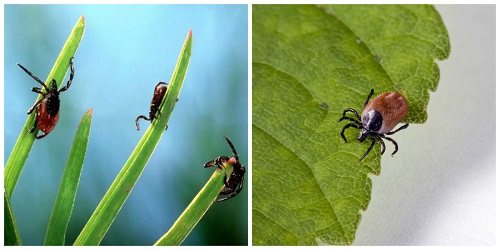

Mites on the grass
Therefore, for a pet, even if it is treated with an anti-mite agent, it is better to do a thorough examination after each walk through the thickets of grass and bushes, probing especially vulnerable places on the body that are preferred by bloodsuckers:
- head and ear area;
- neck and chest;
- front and hind legs, groin area.
Unfortunately, not a single, even the best remedy will completely save the dog from tick-borne attacks, which is why dog owners should not lose their vigilance in a dangerous season - if treatment is not started on time, the death of the pet is inevitable.
Naturally, the symptoms of piroplasmosis in a dog after a tick bite will not be caused by every parasite found on it, but visually, alas, no one can determine whether a tick is dangerous or sterile.
Therefore, only one fact of the presence of a sucked bloodsucker on a pet is obliged to alert the responsible owner, ignoring and frivolity in such cases often leads to the loss of a four-legged friend.
Prophylaxis
Nowadays there is no one hundred percent protection against ticks, but you can try to protect the dog from ticks while walking.
- After all walks, be sure to examine the dog, carefully feel the coat.
- From the beginning of April, use special anti-tick products: sprays, collars, drops. They can reduce the chance of picking up a tick by up to 50 percent.
- Before a long trip, carefully treat the pet's coat with protective equipment.
Vaccines and vaccinations
The most effective vaccines against piroplasmosis are Pirodog and Nobivak Piro. They contain a special isolated antigen of piroplasmosis.
Pyrodog
This vaccine is able to induce the development of immunity against babesiosis. Vaccinated dogs develop full-fledged immunity in 14 days, immediately after two vaccinations. Immunity lasts for 6 months.
What to do if a tick is found on a dog
After the examination reveals a tick sticking out of the dog's body, it is better to pull it out as soon as possible. The sooner the fact of a tick bite in a dog is identified, the easier the symptoms and treatment will be, and the more favorable the outcome.
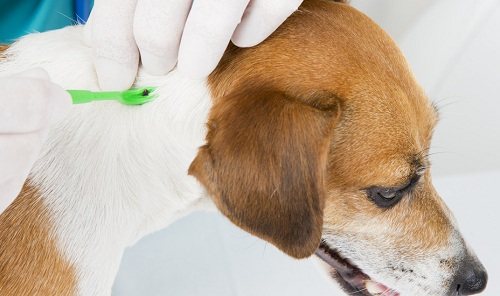

The duration of the bite of an infectious tick in a dog is of great importance, since the entry of pyroplasmas into the victim's body is not interrupted during the period of feeding the bloodsucker. Accordingly, the earlier this process is terminated, the fewer infectious agents will enter the dog's blood, and the easier and more successful the treatment will be.
Feeling the dog, you need to carefully walk along the folds, front suspension and neck, look into the ears, and not forget about the groin.
- A sucked mite is felt through the fur as a hard bump the size of a pea or a small raisin, depending on the size of the portion of blood that the parasite managed to feed on.
- Having parted the fur in a suspicious place and finding a protruding swollen tick, it is removed.
- If a veterinarian is available, then it is better to have such an extraction procedure done by a specialist. But since time does not stand, in the absence of such an opportunity, you can pull out the parasite on your own.
- The best and most convenient way is to remove it with tweezers, when the tick is covered with a tool near the skin, where the proboscis entered the body, and, turning to either side, with a slightly pulling movement, the whole bloodsucker is removed and alive.
- If you don't have tweezers at hand, you can pull out the bloodsucker by hand, wrapped in a napkin or bandage with your fingers. The actions are the same - grab as close to the skin as possible, twist and extract.
- After removing the parasite, the wound on the dog's skin must be carefully disinfected, the tick must be burned, scalded, or thoroughly crushed between layers of paper or cloth, and only then discarded.
Important! Possible signs of infection from a tick bite in a dog appear only when it is attacked by a tick infected with piroplasmas. Not all of the listed symptoms will necessarily appear in a bitten dog, even if it gets infected.Therefore, it is so important to watch your pet carefully for a week, and in case of the slightest deterioration, run to the veterinarian to start treatment.
Probable lesion sites
Usually, the primary lesions occur on the skin in the head region, in particular - the brow ridges, lips, cheeks. Also, the tick often affects places such as the elbows and neck.
After the mite begins to infect these areas of the skin, it moves to the skin in other areas of the body. On the affected areas hair falls out, the skin begins to redden, cracks. At the same time, an ichor stands out from the cracks.
Itching is practically absent or mild. Animals lick such places. The scaly phase of the lesion lasts several months.
Did you know? FROMThe oldest dog in the world - a terrier named Max, has reached the age of 30. By human standards, this equates to 210 years!
What to do if a tick is not found on a dog, but there are symptoms of piroplasmosis
Very often there is a picture when no tick was found in the dog, and the dog suddenly falls ill, and the symptomatology resembles piroplasmosis.
- This phenomenon can be explained by the fact that either, when examining the dog, the parasite had not yet had time to suck, but only wandered in the wool in search of a convenient place, or, having had enough, it had already fallen off without being detected.
- Such cases are dangerous in that the owners write off the dog's malaise by accidental poisoning or some other disease, and sometimes they begin their own improper treatment.
- The absence of a protruding bloodsucker on the dog's body makes it difficult to link symptoms with a tick bite in a dog, what to do - many in such cases do not know. The most important thing here is to pay attention to the color of the urine! If it has darkened, then there is piroplasmosis! The diagnosis is confirmed by a blood test taken from the dog at the veterinary clinic.
For your information! To avoid such misses, veterinarians advise to probe the pet not only upon arrival from a walk, but also after 2 - 3 hours, in order to find the sucked parasite for sure.
Preventive measures
In order to prevent infection of dogs with subcutaneous ticks, you need to follow the simple rules of care and maintenance, set out below:


- Provide pets with a balanced diet, cleanliness in places of detention.
- Prevent dogs from communicating with stray animals.
- Examine hunting dogs regularly for otodectosis infections, sarcoptic mange or demodicosis from wild animals during hunting.
- When keeping several dogs, observe the rule of individual hygiene: Each dog has its own grooming tools.
- It is important to wash your hands thoroughly after contact with infected animals., use replacement shoes and clothing, as humans can transfer ticks from one animal to another.
- When working with animals sick with notoedrosis, gloves should be used, mask, shoe covers, change of clothes and remember that a person can become infected with notoedres.
- It is possible to use acaricidal drops, a wide range of which is presented today in veterinary pharmacies. However, not all of them are equally effective, and it is also important to remember that constantly using such drops, you expose the animal to intoxication.
How is piroplasmosis treated?
Prescribing treatment for an infected dog after a tick bite is based on laboratory data. Blood under a microscope clearly shows the presence of pyroplasmas. The therapy is aimed in a complex at destroying pathogens and cleansing the dog's body from intoxication caused by the activity of the infection.
- Treatment is prescribed exclusively by a veterinarian, self-medication is unacceptable and entails negative consequences for the dog.
- You can often find folk advice on how to treat a dog after a tick bite. Exotic recipes are offered, up to the infusion of vodka.
- This is absolutely not worth doing! Not only will such alternative therapy not help the dog, but a precious chance to really cure the pet will be missed!
Important! The sooner the pet is treated, the more opportunities the dog has to survive and recover without consequences!
What is the danger of a tick bite


Piroplasmosis after a single tick bite is an infectious disease that occurs annually in many dogs. Very often, the death of the animal becomes the most deplorable consequence of such a bite, since the insect's poison moves very rapidly inside the dog's body, thereby affecting the central nervous system.
Pyroplasmosis is mostly caused by a single-celled pathogen such as Piroplasma. This pathogen begins to destroy the blood red components very rapidly. Consequently, the body begins to experience a very strong oxygen starvation, which significantly worsens the condition of the pet, which begins to weaken every day.
The body tries very quickly to get rid of toxins by excreting them through the kidneys, which causes irreversible damage to the entire renal system as a whole.
Thus, it is worth noting that an infectious disease spreads in the body very quickly and if you do not pay attention to this in time and do not provide the dog with proper assistance, then after about four to five days the pet will simply die.
Treatment and nutrition of a sick and recovering dog
The bite of an infectious tick in a dog causes symptoms that require treatment and special nutrition, that is, a complex for caring for a sick animal.
After the dog has been bitten by a tick and the dog is diagnosed with piroplasmosis, it is transferred to a diet and adhere to this regime until complete recovery.
- Meals include a light diet without heavy animal fats - chicken fillet, beef tenderloin, oatmeal.
- The food must be freshly prepared, the water must be clean, you can drink rosehip broth without sugar.
- The veterinarian, in order not to prepare food for the dog every time, can advise a ready-made commercial food suitable for this period.
- The sparing regime also applies to walks - training, hunting, competitions and exhibitions are postponed until the veterinarian allows it.
- The load on the body of a recovering dog should be minimal - a leisurely step, short walks over short distances, restrictions on outdoor games.
The duration of treatment and recovery of the dog depends on the severity of the infection, and may take 1 - 2 months or longer. To control severely ill-tolerated dogs, you will have to donate blood again and show your pet to a doctor.

